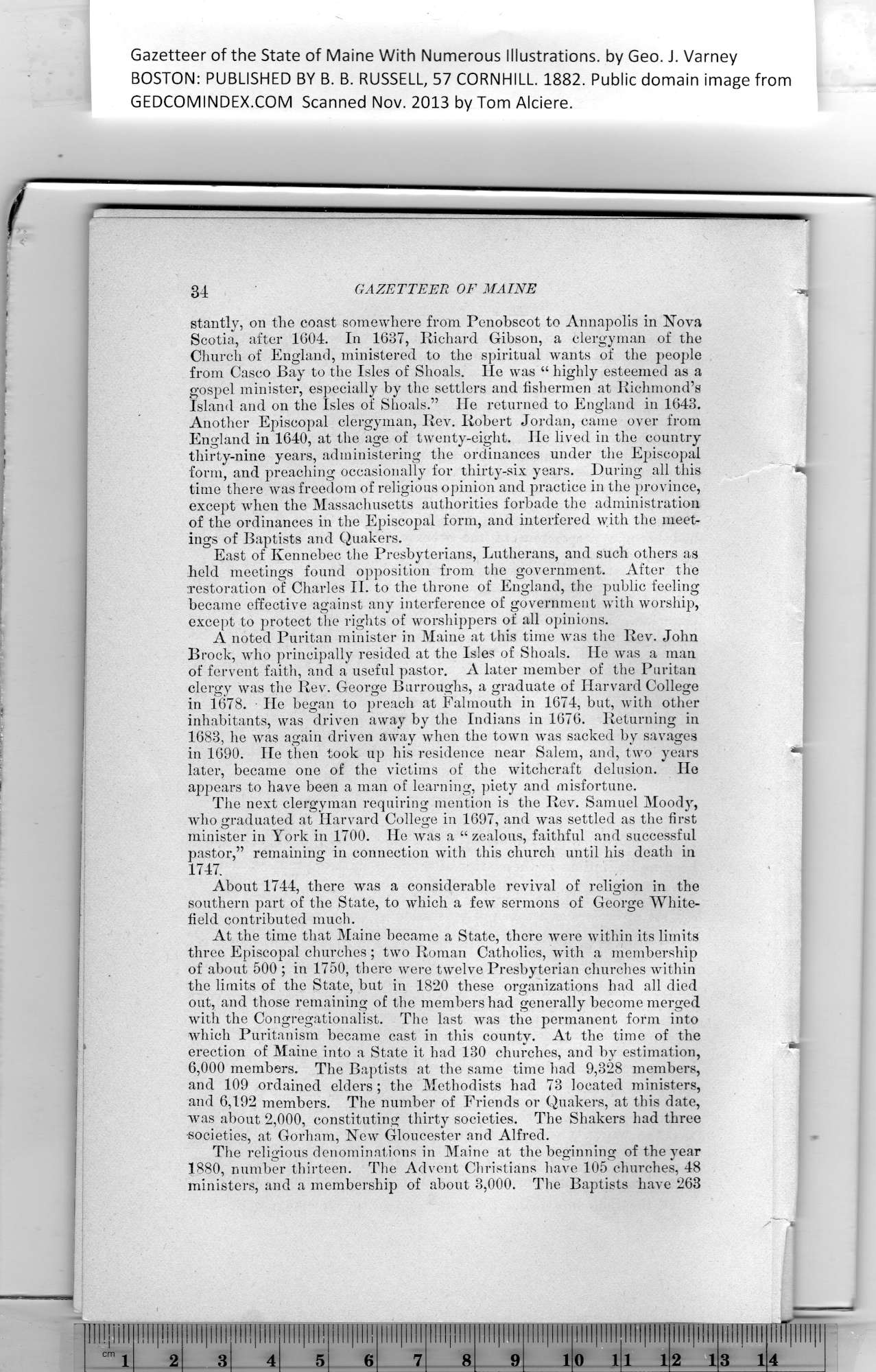|
Gazetteer of the State of Maine With Numerous Illustrations, by Geo. J. Varney
BOSTON: PUBLISHED BY B. B. RUSSELL, 57 CORNHILL. 1882. Public domain image from
34 GAZETTEER OF MAINE
stantly, on the coast somewhere from Penobscot to Annapolis in Nova
Scotia, after 1604. In 1637, Richard Gibson, a clergyman of the
Church of England, ministered to the spiritual wants of the people
from Casco Bay to the Isles of Shoals. He was “ highly esteemed as a
gospel minister, especially by the settlers and fishermen at Richmond’s
Island and on the Isles of Shoals.” He returned to England in 1643.
Another Episcopal clergyman, Rev. Robert Jordan, came over from
England in 1640, at tlie age of twenty-eight. He lived in the country
thirty-nine years, administering the ordinances under the Episcopal
form, and preaching occasionally for thirty-six years. During all this *-
time there was freedom of religious opinion and practice in the province,
except when the Massachusetts authorities forbade the administration
of the ordinances in the Episcopal form, and interfered with the meet-
ings of Baptists and Quakers.
East of Kennebec the Presbyterians, Lutherans, and such others as
held meetings found opposition from the government. After the
restoration of Charles II. to the throne of England, the public feeling
became effective against any interference of government with worship,
except to protect the rights of worshippers of all opinions.
A noted Puritan minister in Maine at this time was the Rev. John
Brock, who principally resided at the Isles of Shoals. He was a man
of fervent faith, and a useful pastor. A later member of the Puritan
clergy was the Rev. George Burroughs, a graduate of Harvard College
in 1678. • He began to preach at Falmouth in 1674, but, with other
inhabitants, was driven away by the Indians in 1676. Returning in
1683, he was again driven away when the town was sacked by savages
in 1690. He then took up his residence near Salem, and, two years
later, became one of the victims of the witchcraft delusion. He
appears to have been a man of learning, piety and misfortune.
The next clergyman requiring mention is the Rev. Samuel Moody,
who graduated at Harvard College in 1697, and was settled as the first
minister in York in 1700. He was a “ zealous, faithful and successful
pastor,” remaining in connection with this church until his death in
1.747.
About 1744, there was a considerable revival of religion in the
southern part of the State, to which a few sermons of George White-
field contributed much.
At the time that Maine became a State, there were within its limits
three Episcopal churches; two Roman Catholics, with a membership
of about 500 ; in 1750, there were twelve Presbyterian churches within
the limits of the State, but in 1820 these organizations had all died
out, and those remaining of the members had generally become merged
with the Congregationalism The last was the permanent form into
which Puritanism became cast in this county. At the time of the
erection of Maine into a State it had 130 churches, and by estimation,
6,000 members. The Baptists at the same time had 9,328 members,
and 109 ordained elders; the Methodists had 73 located ministers,
and 6,192 members. The number of Friends or Quakers, at this date,
was about 2,000, constituting thirty societies. The Shakers had three
•societies, at Gorham, New Gloucester and Alfred.
The religious denominations in Maine at the beginning of the year
1880, number thirteen. The Advent Christians have 105 churches, 48
ministers, and a membership of about 3,000. The Baptists have 263
PREVIOUS PAGE ... NEXT PAGE
This page was written in HTML using a program written in Python 3.2
|
